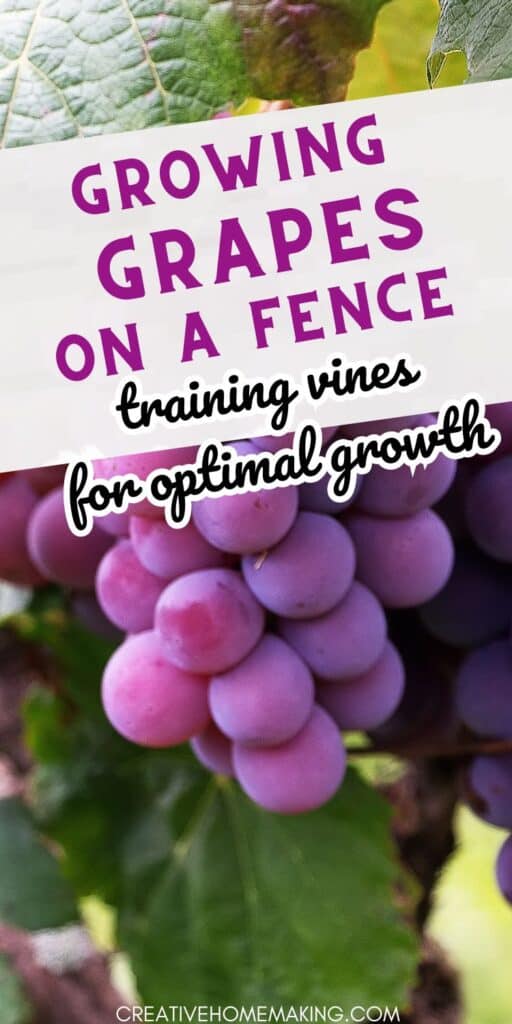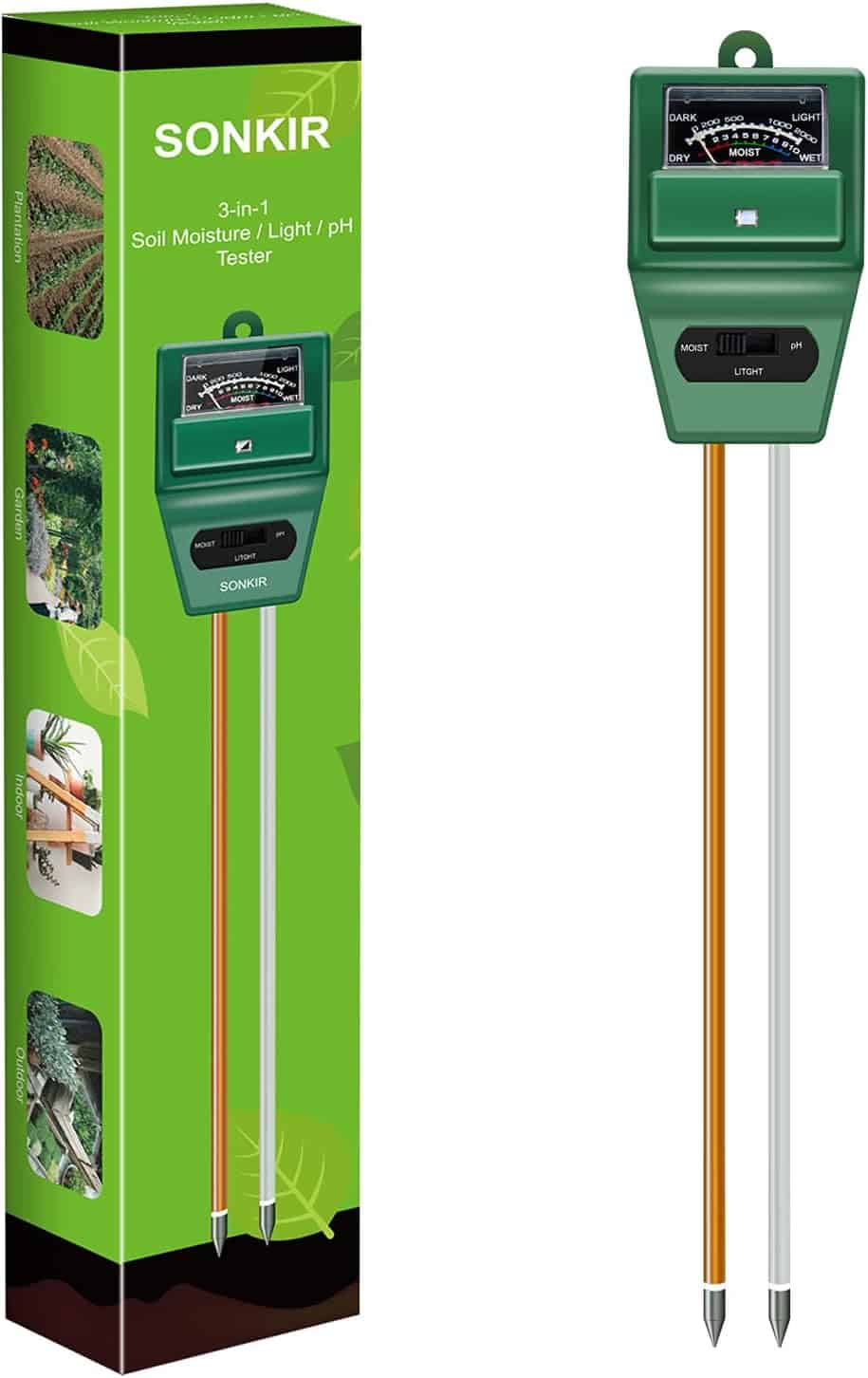Are you looking for a unique way to grow grapes in your garden? Why not try growing grapes on a fence? Not only does it save space, but it also adds an interesting visual element to your garden. Plus, it can be a fun and rewarding project for the whole family.
This post may contain affiliate links.
Growing grapes on a fence is a great option for those with limited space. It allows you to grow grapes vertically, which can be especially beneficial for those with small gardens.
Additionally, growing grapes on a fence can help keep the fruit off the ground, making it less susceptible to pests and disease. Plus, it can be a great way to create a natural privacy screen or add some visual interest to an otherwise bland fence.
Related Article: Growing Grapes in Pots: Tips and Tricks for Successful Container Gardening
When it comes to selecting the right grape variety for your fence, there are a few things to consider. Some varieties are better suited for growing vertically, while others may require more space to spread out.
It’s also important to choose a variety that is well-suited for your climate and growing conditions. With a little research and planning, you can create a beautiful and productive grape fence in your own backyard.
Related Article: Growing Grapes on a Trellis
Choosing the Right Grape Variety
When it comes to growing grapes on a fence, choosing the right grape variety is crucial. Here are some things to consider when selecting a grape variety:
European Grapes
European grapes are known for their sweet and complex flavors. They are also known for being more difficult to grow than other varieties. If you live in a warm climate and have experience growing grapes, European grapes may be a good choice for you.
Related Article: Best Grapes for Red Wine: A Friendly Guide to Top Varieties
Concord Grapes
Concord grapes are a popular variety for making juice and jelly. They are also hardy and easy to grow, making them a good choice for beginners. Concord grapes have a distinctive sweet and tangy flavor that is perfect for snacking.
Hybrids
Hybrid grapes are a cross between two or more grape varieties. They are often bred to be disease-resistant and easier to grow than their parent varieties. Some popular hybrid grapes include the Chambourcin and the Vignoles.
Seedless Grapes
Seedless grapes are a popular choice for snacking because they are easy to eat and don’t require any messy seed removal. Some popular seedless grape varieties include the Flame Seedless and the Thompson Seedless.
Related Article: What to Do With Homegrown Grapes
Seedless Varieties
Seedless varieties are a great choice if you want to avoid the hassle of removing seeds. They are also a good choice for making raisins. Some popular seedless grape varieties include the Red Globe and the Crimson Seedless.
When choosing a grape variety, consider your climate, experience level, and intended use. With the right grape variety and some care and attention, you can grow delicious grapes on your fence.
Preparing the Soil
Before planting grapes on a fence, it’s important to prepare the soil properly. The quality of the soil will have a significant impact on the growth and health of your grape plants. Here are some tips for preparing the soil:
Soil Type
Grapes prefer well-drained soil, so it’s important to choose a location with good drainage. If your soil is heavy clay or compacted, you may need to amend it to improve drainage.
You can do this by adding organic matter, such as compost or well-rotted manure, to the soil. This will also help improve soil structure and fertility.
Related Article: Growing Grapes from Cuttings: A Beginner’s Guide
Soil Testing
Before planting, it’s a good idea to test your soil to determine its pH and nutrient levels. You can purchase a soil testing kit at your local garden center or have your soil tested by a professional.
This will help you determine if you need to add any amendments to the soil, such as lime to raise the pH or sulfur to lower it.
Compost
Adding compost to the soil is an excellent way to improve soil fertility and structure. Compost is rich in organic matter, which provides essential nutrients to plants and helps improve soil texture.
You can make your own compost by collecting yard waste and kitchen scraps, or you can purchase compost from a garden center.
Drainage
As mentioned earlier, good drainage is essential for growing grapes. If your soil doesn’t drain well, you can improve drainage by adding organic matter, such as compost or well-rotted manure, to the soil. You can also create raised beds or mounds to improve drainage.
Related Article: Canning Grape Juice
Ground Preparation
Before planting, it’s important to prepare the ground properly. Remove any weeds or grass from the planting area and loosen the soil to a depth of at least 12 inches.
You can use a garden fork or tiller to accomplish this. Once the soil is loosened, add any necessary amendments, such as compost or lime, and mix well.
Planting the Grapevines
Planting grapevines on a fence is an excellent way to utilize vertical space and grow your own delicious grapes. Before you start planting, it’s important to choose the right variety of grapevine for your climate and soil type.
When planting bare-root grapevines, soak the roots in water for a few hours before planting. Dig a hole that is deep enough to accommodate the roots without bending them, and wide enough to allow for good root growth.
Related Article: How to Prune Grapes: A Beginner’s Guide
Mix compost or well-rotted manure into the soil at the bottom of the hole. Place the grapevine in the hole, making sure that the graft union is above the soil level. Fill the hole with soil, gently firming it around the roots.
Water the grapevine thoroughly after planting, and continue to water it regularly until it becomes established. If you are planting several grapevines, space them about 8 feet apart along the fence.
If you are planting grapevines from seeds, start them indoors in the late winter or early spring. Plant the seeds in seed-starting mix, and keep them moist and warm until they germinate.
Once the seedlings have developed a few leaves, transplant them into individual pots and continue to care for them indoors until the weather warms up.
Related Article: Canning Grape Jelly
Building a Support System
Growing grapes on a fence is a great way to save space and create a beautiful garden feature. However, before you start planting, you need to build a support system to ensure your grapevines grow properly. Here are some steps to help you build a sturdy support system for your grapevines.
Step 1: Choose a Fence
The first step is to choose a fence that can support the weight of your grapevines. A sturdy fence made of wood or metal is ideal. If you don’t have a fence, you can use a post or a trellis to support your grapevines.
Step 2: Install Posts
If you’re using a fence, you don’t need to install posts. However, if you’re using a trellis or a post, you need to install posts to support your grapevines. Use a post hole digger to dig holes for your posts.
The depth of the holes should be at least 2 feet deep. Once you’ve dug the holes, insert the posts and fill the holes with concrete to secure them in place.
Step 3: Install the Trellis or Arbor
Once your posts are in place, you need to install your trellis or arbor. A trellis is a frame made of wood or metal that supports your grapevines. An arbor is a frame with an arch that you can walk under. You can use wire or string to attach your grapevines to the trellis or arbor.
Step 4: Attach Wires
If you’re using a trellis, you need to attach wires to support your grapevines. Attach the wires to the top of the trellis and space them about 18 inches apart. You can use eye bolts to attach the wires to the trellis.
Step 5: Create a Support System
Finally, you need to create a support system for your grapevines. You can use a frame made of wood or metal to support your grapevines. If you’re using a chain-link fence, you can attach your grapevines directly to the fence.
Use materials that are strong and durable so that your support system can withstand the weight of your grapevines.
Training and Pruning Grapevines
Training and pruning grapevines are essential to maintain healthy growth and high yield of grapes. Proper pruning and training techniques help to promote the growth of new fruiting wood, increase sunlight exposure, and improve air circulation. Here are some tips on how to train and prune your grapevines.
Pruning Grapevines
Pruning grapevines is done during the dormant season, usually in late winter or early spring. The purpose of pruning is to remove old wood and stimulate new growth. Here are some steps to follow when pruning your grapevines:
- Use sharp pruning shears to make clean cuts.
- Identify the main canes that will be trained along the fence.
- Cut off any lateral shoots that grow from the main canes.
- Cut back the main canes to about 3-4 buds.
- Remove any diseased or damaged wood.
Training Grapevines
Training grapevines along a fence is a great way to save space and make harvesting easier. Here are some steps to follow when training your grapevines:
- Attach a wire or trellis to the fence at a height of about 3-4 feet.
- Tie the main canes to the wire using soft twine or vine clips.
- As the vines grow, tie them to the wire, spacing them out evenly.
- Remove any lateral shoots that grow from the main canes.
- Train the new shoots along the wire as they grow.
Taking Cuttings
If you want to propagate new grapevines, you can take cuttings from your existing vines. Here are some steps to follow when taking cuttings:
- Cut off a 12-inch section of new growth from your grapevine.
- Remove any leaves from the bottom half of the cutting.
- Dip the bottom end of the cutting in rooting hormone.
- Plant the cutting in a pot filled with soil.
- Keep the soil moist and in a warm, sunny location.
By following these tips for training and pruning grapevines, you can ensure healthy growth and a bountiful harvest of delicious grapes.
Maintaining Healthy Grapevines
Growing grapes on a fence can be a rewarding experience, but it requires proper maintenance to ensure healthy and productive plants. Here are some tips to help you maintain healthy grapevines:
Watering
Grapevines require regular watering, especially during the growing season. Make sure to water your plants deeply, at least once a week, to encourage deep root growth. Avoid overwatering, as it can lead to root rot and other fungal diseases.
Sun Exposure
Grapevines require full sun exposure to produce healthy fruit. Make sure your fence is located in a sunny area, and avoid planting grapevines in shady areas.
Fertilizer
Fertilize your grapevines with a balanced fertilizer once a year, in early spring. Avoid over-fertilizing, as it can lead to excessive vegetative growth and reduced fruit production.
Powdery Mildew
Powdery mildew is a common fungal disease that can affect grapevines. To prevent powdery mildew, make sure your plants are well-ventilated and avoid overhead watering.
Pests
Grapevines can be affected by a variety of pests, including aphids, spider mites, and grape berry moths. Monitor your plants regularly for signs of pest infestations, and treat them promptly with insecticidal soap or other appropriate treatments.
Netting
Protect your grapevines from birds and other animals by covering them with netting. Make sure the netting is securely fastened to prevent birds from getting trapped.
Diseases
Grapevines can be affected by a variety of diseases, including downy mildew and black rot. Monitor your plants regularly for signs of disease, and treat them promptly with appropriate fungicides.
Mulching
Mulching your grapevines can help retain moisture and suppress weeds. Use organic mulch, such as straw or wood chips, and avoid piling it up against the base of the plants.
Harvesting and Using Grapes
Once your grapes have ripened, it’s time to harvest them. To ensure the best quality fruit, pick the grapes when they’re fully ripe and juicy. Table grapes are usually harvested when they’re fully colored and have a slightly soft texture.
Juice grapes, on the other hand, are harvested when they’re fully colored and have a very soft texture.
To harvest your grapes, gently pull the clusters from the vine. Be careful not to damage the grapes or the vine. If you’re harvesting a large quantity of grapes, it’s a good idea to use a pair of pruning shears to cut the clusters from the vine.
Once you’ve harvested your grapes, you can use them in a variety of ways. Table grapes are delicious eaten fresh, while juice grapes are perfect for making juice, jellies, and jams.
If you’re using your grapes for juice, you’ll need to remove the stems and crush the grapes to release the juice. You can do this by hand or with a grape crusher.
If you’re planning to make jelly or jam, you’ll need to cook the grapes in a pot with sugar and pectin. Once the mixture has thickened, you can pour it into jars and let it cool. Grape jelly and jam are delicious on toast or as a topping for ice cream.
If you’re using your grapes for juice, you can store the juice in the refrigerator or freeze it for later use. To freeze grape juice, pour it into freezer-safe containers and leave some room at the top for expansion.
When you’re ready to use the juice, simply thaw it in the refrigerator or at room temperature.
Overall, harvesting and using grapes is a fun and rewarding experience. Whether you’re growing table grapes or juice grapes, there are plenty of delicious ways to enjoy your harvest.
Frequently Asked Questions
What are some good grape varieties to grow on a fence?
There are several grape varieties that can be grown on a fence, including Concord, Niagara, and Catawba. These varieties are known for their hardiness and ability to grow in a variety of climates.
How quickly do grape vines grow on a fence?
Grape vines can grow quickly, especially in the first few years. With proper care and maintenance, you can expect your grape vines to grow up to 10 feet in a year.
What is the ideal height for a grape fence?
The ideal height for a grape fence is around 6 to 8 feet. This will allow your grape vines to grow and spread out, while still being easy to maintain and harvest.
Can grape vines grow on any type of fence?
Grape vines can grow on most types of fences, including wooden, chain-link, and vinyl. However, it’s important to ensure that your fence is sturdy and can support the weight of the grape vines.
Is it possible to grow grapes in pots on a fence?
Yes, it’s possible to grow grapes in pots on a fence. This is a great option for those who have limited space or want to grow grapes in a more controlled environment.
What are some tips for growing muscadines on a fence?
Muscadines are a type of grape that can be grown on a fence. To ensure successful growth, make sure to plant them in well-draining soil and provide plenty of water and sunlight. It’s also important to prune your muscadine vines regularly to promote healthy growth and fruit production.
Follow my





